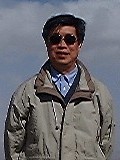Visiting Researchers
Yaolin SHI
 |
|
Report on the Visit to ERI
Kindly invited and support by Earthquake Research Institute of Tokyo University, I, Professor SHI Yaolin as the vice dean of College of Earth Sciences of Graduate University, Chinese Academy of Sciences, made an academic visit to Japan, from January 8 to January 21, 2006. This is part of the bilateral cooperation program between the two universities.
During the visit, I met Professors T. Kato, T. Seno, K. Shimazaki, M. Hori, W. Sun, and S. Honda, exchanged ideas on collaboration and scientific research with them. I discussed with Professor Seno about strain calculation from GPS data, and problems related to error estimates. I learned from Professor Shimazaki the overall state of earthquake prediction in Japan, and with special emphasis on the statistical tests of different forecasts. I discussed with Professor Seno on the nonlinear dynamic features of earthquake generation. I am impressed by introduction of Professor Hori on their work in numerical modeling and visualization, and expect further collaboration between our Laboratory of Computational Geodynamics and ERI. I discussed with Professor Sun about problems found in far field coseismic stress changes, he emphasized the importance of spherical effects for large earthquakes. I exchanged ideas with Professor Honda about mantle convection and its relations to lithosphe! ric tectonics.
I gave a seminar on January 19 about Rheology and Geodynamic modeling of the Tibetan Plateau. As a tectonic active area, temperature beneath the Himalaya and the plateau cannot be estimated from surface heat flow by a steady state thermal conduction, seismic tomography data combined with rock experiments provide estimates of lithospheric temperature affected by advective heat transfer. Lower mantle viscosity can be calculated from the geotherms, and confirmed by GPS observation and visco-elastic modeling of post-seismic deformation. By expressing the basal shear of the lower crust to the upper crust as an equivalent body force in 2-D stress inversion, the lower crust is found to flow clockwise around the eastern Himalaya syntax to pull the upper crust move. Discussions with Japanese audience are fruitful.
I participated the 4th International Statistical Seismology Workshop from January 9 to 14, in which, Professor Shimazaki gave a keynote talk on long-term earthquake forecasts in Japan (1996-2005). I also took this opportunity to make short visit to Professors Takemoto, Fukuda, Kawasaki and Dr. P. Xu of Kyoto University to discuss research on slow earthquakes, and visit to Professors Kitagawa, Higuchi and Ogata of Institute of Statistical Mathematics to discuss data processing of earthquake related observations.
During the visit, I also met Professor Dave Yuen from Minnesota University, had a pleasant party with him and Professors Seno, Honda and Maruyama at the scenery lakeside of Ueno. I also met Professor Kennett at the office for visiting scholars. I feel ERI is an active and vital institute in world seismology research. I made discussions with Professor Kato on the collaboration between our two institutes. Graduate University will continue to invite professors to visit China and give short lectures in summer. We also agreed on Professor Wu¨s suggestion to organize some workshops in the future.
I have a rare opportunity to see the beautiful landscape of largest snow in Tokyo in the latest 20 years, I have no regret although I was delayed at the airport by the snow for one day.
The visit was facilitated by the ERI Office of International Earthquake and Volcano Research Promotion and the Office for International Cooperation of the Graduate University of Chinese Academy of Sciences. Thanks are due to Profs. T. Kato, and W. K. Sun, as well as Ms. Tokie Watanabe and Mr. G. Y. Fu (from the ERI side) and Prof. D. P. Wei and Dr. Xie (from the CAS side), for various helps during the planning, the paper work processing, the traveling, and the stay in Tokyo.
